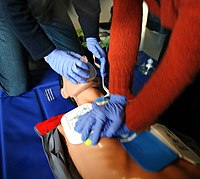
Damage Control Resuscitation in polytrauma patient.
Sign Up to like & getrecommendations! Published in 2019 at "Revista espanola de anestesiologia y reanimacion"
DOI: 10.1016/j.redar.2019.03.009
Abstract: Haemorrhagic shock is one of the main causes of mortality in severe polytrauma patients. To increase the survival rates, a combined strategy of treatment known as Damage Control has been developed. The aims of this… read more here.
Keywords: resuscitation polytrauma; control resuscitation; damage control; damage ... See more keywords

Remote Damage Control Resuscitation: A Case Report of Hemorrhagic Shock Secondary to Multiple Gunshot Wounds.
Sign Up to like & getrecommendations! Published in 2022 at "Military medicine"
DOI: 10.1093/milmed/usac139
Abstract: Hypovolemic shock is the leading cause of preventable death on the battlefield. Remote damage control resuscitation has evolved dramatically in the past decade by introducing novel treatments and approaches to bleeding in the prehospital setting.… read more here.
Keywords: shock; remote damage; control resuscitation; damage control ... See more keywords

Biochemical disturbance in damage control resuscitation: mechanisms, management and prognostic utility
Sign Up to like & getrecommendations! Published in 2022 at "Current Opinion in Anaesthesiology"
DOI: 10.1097/aco.0000000000001226
Abstract: Purpose of review With advances in resuscitative techniques, trauma patients are surviving increasingly severe injuries and physiological insult. Timely recognition of futility remains important in terms of patient dignity and resource preservation yet is increasingly… read more here.
Keywords: resuscitation; biochemical disturbance; control resuscitation; damage control ... See more keywords

Valproic acid decreases resuscitation requirements after hemorrhage in a prolonged damage-control resuscitation model
Sign Up to like & getrecommendations! Published in 2020 at "Journal of Trauma and Acute Care Surgery"
DOI: 10.1097/ta.0000000000002876
Abstract: Supplemental digital content is available in the text. BACKGROUND Hemorrhage is the leading cause of preventable death in trauma. Future military conflicts are likely to be in austere environments, where prolonged damage-control resuscitation (p-DCR) may… read more here.
Keywords: valproic acid; control resuscitation; damage control; resuscitation ... See more keywords

Adopting a culture of remote damage control resuscitation in the military: Insights from the Israel defense forces decade of experience
Sign Up to like & getrecommendations! Published in 2023 at "Transfusion"
DOI: 10.1111/trf.17357
Abstract: Remote damage control resuscitation (RDCR) aims to apply the principles of damage control resuscitation to prehospital and austere care, emphasizing early control of compressible hemorrhage, balanced volume resuscitation, and the prevention or correction of coagulopathy,… read more here.
Keywords: control resuscitation; control; remote damage; resuscitation ... See more keywords

Training for damage control resuscitation using a rapid infuser
Sign Up to like & getrecommendations! Published in 2017 at "Journal of the Royal Army Medical Corps"
DOI: 10.1136/jramc-2016-000711
Abstract: Damage control resuscitation (DCR)[1][1] is now the gold standard of care for treating casualties involved in complex trauma, which involves permissive hypotension, damage control surgery and haemostatic resuscitation, where blood and blood products are administered… read more here.
Keywords: control resuscitation; damage control; training damage; damage ... See more keywords

Damage control resuscitation: a practical approach for severely hemorrhagic patients and its effects on trauma surgery
Sign Up to like & getrecommendations! Published in 2017 at "Journal of Intensive Care"
DOI: 10.1186/s40560-016-0197-5
Abstract: Coagulopathy observed in trauma patients was thought to be a resuscitation-associated phenomenon. The replacement of lost and consumed coagulation factors was the mainstay in the resuscitation of hemorrhagic shock for many decades. Twenty years ago,… read more here.
Keywords: damage control; control; control resuscitation; trauma ... See more keywords

Immunopathological Alterations after Blast Injury and Hemorrhage in a Swine Model of Prolonged Damage Control Resuscitation
Sign Up to like & getrecommendations! Published in 2023 at "International Journal of Molecular Sciences"
DOI: 10.3390/ijms24087494
Abstract: Trauma-related hemorrhagic shock (HS) remains a leading cause of death among military and civilian trauma patients. We have previously shown that administration of complement and HMGB1 inhibitors attenuate morbidity and mortality 24 h after injury… read more here.
Keywords: control resuscitation; damage; model; injury ... See more keywords